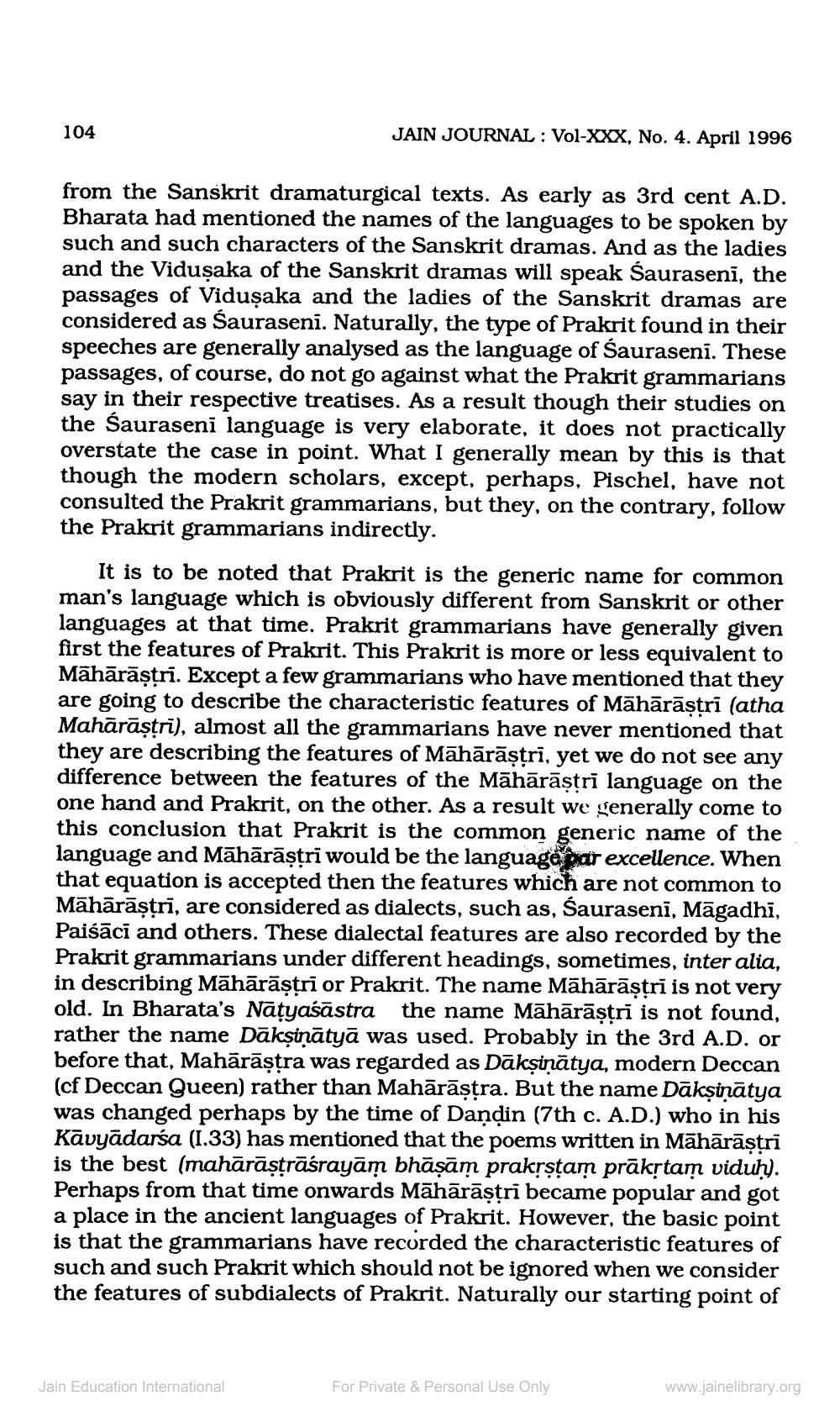Book Title: Jain Journal 1996 04 Author(s): Jain Bhawan Publication Publisher: Jain Bhawan Publication View full book textPage 6
________________ 104 JAIN JOURNAL: Vol-XXX, No. 4. April 1996 from the Sanskrit dramaturgical texts. As early as 3rd cent A.D. Bharata had mentioned the names of the languages to be spoken by such and such characters of the Sanskrit dramas. And as the ladies and the Viduṣaka of the Sanskrit dramas will speak Sauraseni, the passages of Viduṣaka and the ladies of the Sanskrit dramas are considered as Sauraseni. Naturally, the type of Prakrit found in their speeches are generally analysed as the language of Śauraseni. These passages, of course, do not go against what the Prakrit grammarians say in their respective treatises. As a result though their studies on the Sauraseni language is very elaborate, it does not practically overstate the case in point. What I generally mean by this is that though the modern scholars, except, perhaps, Pischel, have not consulted the Prakrit grammarians, but they, on the contrary, follow the Prakrit grammarians indirectly. It is to be noted that Prakrit is the generic name for common man's language which is obviously different from Sanskrit or other languages at that time. Prakrit grammarians have generally given first the features of Prakrit. This Prakrit is more or less equivalent to Mahārāṣṭri. Except a few grammarians who have mentioned that they are going to describe the characteristic features of Māhārāṣṭrī (atha Mahārāṣṭri), almost all the grammarians have never mentioned that they are describing the features of Mahārāṣṭri, yet we do not see any difference between the features of the Mahārāṣṭrī language on the one hand and Prakrit, on the other. As a result we generally come to this conclusion that Prakrit is the common generic name of the language and Māhārāṣṭrī would be the language par excellence. When that equation is accepted then the features which are not common to Māhārāṣṭrī, are considered as dialects, such as, Šauraseni, Māgadhi, Paiśāci and others. These dialectal features are also recorded by the Prakrit grammarians under different headings, sometimes, inter alia, in describing Māhārāṣṭri or Prakrit. The name Māhārāṣṭri is not very old. In Bharata's Natyaśāstra the name Māhārāṣṭrī is not found, rather the name Dākṣinātyā was used. Probably in the 3rd A.D. or before that, Mahārāṣṭra was regarded as Dākṣinātya, modern Deccan (cf Deccan Queen) rather than Mahārāṣṭra. But the name Dākṣinātya was changed perhaps by the time of Dandin (7th c. A.D.) who in his Kavyadarsa (1.33) has mentioned that the poems written in Māhārāṣṭri is the best (mahārāṣṭrāśrayām bhāṣām prakṛṣṭam prākṛtam viduḥ). Perhaps from that time onwards Māhārāṣṭri became popular and got a place in the ancient languages of Prakrit. However, the basic point is that the grammarians have recorded the characteristic features of such and such Prakrit which should not be ignored when we consider the features of subdialects of Prakrit. Naturally our starting point of Jain Education International For Private & Personal Use Only www.jainelibrary.orgPage Navigation
1 ... 4 5 6 7 8 9 10 11 12 13 14 15 16 17 18 19 20 21 22 23 24 25 26 27 28 29 30 31 32 33 34 35 36 37 38 39 40 41 42 43 44 45 46 47 48 49 50 51 52 53 54 55
